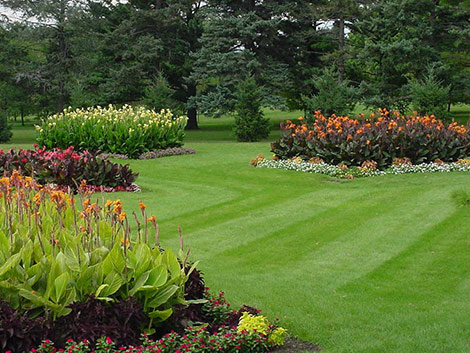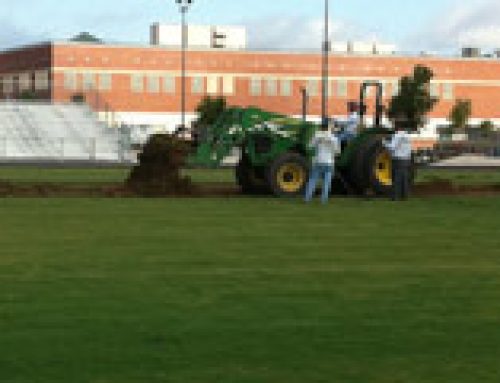Whether you are growing peppers, zinnias, or grass, soil is the foundation for a healthy plant. There are a variety of nutrients found in soil that are necessary for plant growth. When nutrients become imbalanced, plants might become discolored, growth can be stunted, or fruits and vegetables might misshape. In order to provide the best environment for your plants to grow, it is important to understand what elements are at work in soil, how to measure the soil in your own yard, and how to manage and augment nutrients to your garden or lawn.
Nutrients Needed for Plant Growth:
- Nitrogen is important for plant growth and makes plant leaves and their stems green.
- Phosphorus makes plants resistant to disease and produces fruit, flowers, and seeds.
- Potassium also makes plants resistant to disease and helps root growth and strength.
- Other micronutrients include magnesium, iron, calcium, boron, sulfur, zinc, and manganese.
Your Plants are Telling You Something!
One of the easiest ways of monitoring your plants is simple: look at them! Your plants and lawn give you information about what is going on in the ground in which they live; you simply need to know how to read the signs.
- Nitrogen deficiency stunts growth and older leaves become discolored.
- Phosphorus deficiency turns red veins to purple.
- Potassium deficiency causes the tips of leaves to turn brown and the edges of older leaves to turn purple.
- Magnesium deficiency causes older leaves to become a spotted yellow or tan.
- Iron deficiency stunts new growth, but veins stay green.
There are a number of clues your plants give you to provide evidence about soil nutrient content, but the most reliable method is a soil test. A soil test will give you concrete information about how much nitrogen, phosphorus, and potassium are in the soil as well as the pH so that you can better understand the needs of your soil and plants.
Once you understand your soil’s nutrient content, you can determine whether increasing one or more elements is necessary. There are a variety of options available for nutrient supplements and fertilizers. Be sure to weigh your options and decide which method is right for your soil.
Fertilizer Options
Commercial fertilizers are required to print the percentages of nitrogen, phosphorus, and potassium on the label. On such labels, three numbers will be printed (for example, 10-20-10) and each number corresponds to nitrogen, phosphorus, and potassium respectively. Chemical fertilizers often contain other elements and nutrients that also assist in plant health.
In terms of form, there are two main types of chemical fertilizers: liquid and granular. Liquid fertilizers are fast acting, but require more frequent application. Granular fertilizers, on the other hand, are spread over the desired area and then watered. Within granular, there are both quick release and slow release fertilizers. Apply chemical fertilizers as you prepare your garden, at least several days before planting to avoid burning or damaging the plants.
Organic fertilizers are a smart choice if you have small children or pets, or if you are planning on eating from the plants. Commercially produced organic fertilizers can be found at any gardening store, but there are also several methods that provide the basic nutrients as well as more micronutrients. Compost and grass clippings are excellent sources of nutrients for your lawn or garden and come to you at little or no cost. Save time and money when you mow the lawn, and do not bag up the grass clippings. Simply leave the clippings where they fall to give your lawn a nutrient boost.
Why pH is Important
As mentioned above, a soil test tells you the pH level present. The pH scale measures the acidity/alkalinity of the soil, with lower numbers corresponding to higher acidity/lower alkalinity and higher numbers corresponding to lower acidity/higher alkalinity.
A pH of 6.5 is the point where most plant nutrients are available, but each plant has a recommended pH level. Thus, if your pH does not fall into an appropriate range, fertilizers will not help because the nutrients needed are unavailable at that pH level.
If pH adjustment proves necessary, try these techniques:
If you need to lower acidity, use limestone products and hydrated lime. For best results, this needs to be done several months before planting. Wood ashes are also effective.
If you need to raise acidity, aluminum sulfate and sulfur can both be found at any gardening store and are effective when used carefully.
Even though plants grown in nature or organically rich environments do not need our involvement to maintain healthy nutrient levels, our flowerbeds, container gardens, and lawns do not have the same naturally occurring decomposing cycles. So, nutrient balance and fertilizers might be necessary for healthy growth. Knowing how to read soil testing results can help ensure a productive growing season or lush lawn this year. Call Bob Jenkins Pest & Lawn Services to help your yard this summer.



